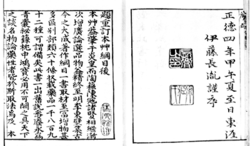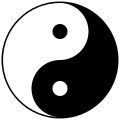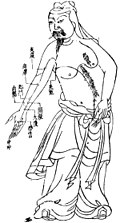Traditional Chinese medicine
Traditional Chinese medicine (TCM) is a branch of traditional medicine from China. It is at least 3,500 years old. Treatments include herbal medicine, acupuncture, cupping, massage, and exercise. Since the methods of TCM are different from Western medicine, it is hard to find evidence that shows how safe or good TCM really is.
Many of the most important ideas in TCM are based on the teachings of Daoism. Based on the teachings of TCM, it is important to balance the five elements in a person's body: wood, fire, earth, metal, and water. Each element also has something called yin and yang, or opposite values that must exist alongside each other rather than to overcome the other. The way to balance the yin and yang is to strengthen qi, or an invisible force that brings balance to the yin and yang. Knowing the five elements and the yin and yang is important because each organ of the body is related to one of the five elements. It is important to strengthen a person's qi because balancing the yin and yang of a person's organs is important for people to be healthy.[1] The different treatments in TCM are made to bring balance to the elements in a person's body.
These ideas are similar to, but not the same as, the four temperaments, which was an widely believed theory in European medicine before scientific medicine was created. In the 19th century, many European doctors working as missionaries in China started translating TCM. For example, Dr. Gottlieb Olpp helped spread it to Germany. TCM also has a lot to do with how mentally stable you are in the process of your healing.
Traditional Chinese Medicine Media
The Compendium of Materia Medica is a pharmaceutical text written by Li Shizhen (1518–1593) during the Ming dynasty of China. This edition was published in 1593.
Acupuncture chart from Hua Shou (fl. 1340s, Yuan dynasty). This image from Shisi jingfahui (Expression of the Fourteen Meridians). (Tokyo: Suharaya Heisuke kanko, Kyoho gan 1716).
Apothecary mixing traditional Chinese medicine at Jiangsu Chinese Medical Hospital, Nanjing, China
Assorted dried plant and animal parts used in traditional Chinese medicines, clockwise from top left corner: dried Lingzhi (lit. 'spirit mushrooms'), ginseng, Luo Han Guo, turtle shell underbelly (plastron), and dried curled snakes.
References
- ↑ Supervisor, Dr Chuanxin Wang-OM Clinical / Faculty. "Taoism and Traditional Chinese Medicine (TCM)". www.amcollege.edu. Archived from the original on 2020-06-30. Retrieved 2020-06-26.









